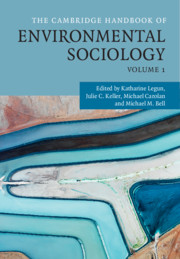Book contents
- The Cambridge Handbook of Environmental Sociology Volume 1
- The Cambridge Handbook of Environmental Sociology
- Copyright page
- Contents
- Figures
- Tables
- Contributors
- Foreword
- Introduction
- Part I Theory in Environmental Sociology
- Part II The Economy and Environmental Sociology
- Part III Culture and Environmental Sociology
- 12 Media and the Environmental Movement in a Digital Age
- 13 National Parks and (Neo)Colonialisms
- 14 Post Carbon Transition Futuring: For a Reconstructive Turn in the Environmental Social Sciences?
- 15 Outer Space and New Frontiers to Environmental Imaginations
- 16 New Territory for Environmental Sociology: Environmental Philosophy and Nature-Based Tourism
- Part IV Politics, Power, State
- Part V Social Justice
- Index
- References
12 - Media and the Environmental Movement in a Digital Age
from Part III - Culture and Environmental Sociology
Published online by Cambridge University Press: 05 November 2020
- The Cambridge Handbook of Environmental Sociology Volume 1
- The Cambridge Handbook of Environmental Sociology
- Copyright page
- Contents
- Figures
- Tables
- Contributors
- Foreword
- Introduction
- Part I Theory in Environmental Sociology
- Part II The Economy and Environmental Sociology
- Part III Culture and Environmental Sociology
- 12 Media and the Environmental Movement in a Digital Age
- 13 National Parks and (Neo)Colonialisms
- 14 Post Carbon Transition Futuring: For a Reconstructive Turn in the Environmental Social Sciences?
- 15 Outer Space and New Frontiers to Environmental Imaginations
- 16 New Territory for Environmental Sociology: Environmental Philosophy and Nature-Based Tourism
- Part IV Politics, Power, State
- Part V Social Justice
- Index
- References
Summary
In a seminal article from the early 1990s, Gamson and Wolfsfeld (1993) characterize the relationship between mass media and social movements as one of "asymmetrical dependency," whereby the former rely on the latter for three purposes: to mobilize their constituencies; to validate their existence as politically important collective actors; and to enlarge the scope of conflict, drawing in third parties. In this chapter, I review scholarly research on the media and the environmental movement over the last half century. As helpful as this has been, it focuses almost entirely on traditional media, ignoring the tumultuous changes that have occurred in political communication associated with the Internet, Twitter, Facebook, Snapchat, Instagram and other new media platforms and technologies. Analysis of several case studies of new media and environmental campaigns suggests that the most effective movement strategy is to embrace a "hybrid media" system which blends older media logics, notably those associated with broadcast television, with new digital media logics.
- Type
- Chapter
- Information
- The Cambridge Handbook of Environmental Sociology , pp. 193 - 205Publisher: Cambridge University PressPrint publication year: 2020

